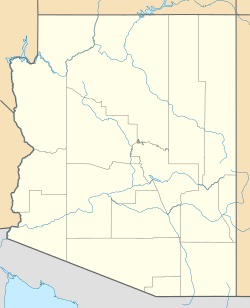Antelope Hill Highway Bridge facts for kids
Quick facts for kids Antelope Hill Highway Bridge |
|
|---|---|
| Coordinates | 32°43′8″N 114°0′43″W / 32.71889°N 114.01194°W |
| Carries | Ocean to Ocean Highway (formerly) |
| Crosses | Gila River |
| Locale | Yuma County, Arizona |
| Named for | Antelope Hill, Arizona |
| Owner | Yuma County |
| Characteristics | |
| Design | Twin concrete girder multi-span bridge |
| Material | Concrete |
| Pier construction | Timber |
| Total length | 975 feet (297 m) |
| Width | 18 feet (5 m) |
| Traversable? | No |
| Longest span | 65 feet (20 m) |
| Number of spans | 15 |
| History | |
| Architect | Lamar Cobb |
| Constructed by | Perry Borchers (initially) Arizona Highway Department aided by Arizona State Penitentiary convict labor (Winter 1914 onward) |
| Construction begin | 1914 |
| Construction end | 1915 |
| Opened | 18 August 1915 |
| Rebuilt | 1917; 1918 |
| Collapsed | After 1929 |
| Closed | 1929 |
|
Antelope Hill Highway Bridge
|
|
| Nearest city | Tacna, Arizona |
| Area | 0.4 acres (0.16 ha) |
| Built | 1914 to 1915 |
| Built by | Perry E. Borchers (started) Arizona State Highway Department (finished) with Arizona State Penitentiary convict laborers |
| Architectural style | Concrete Girder |
| MPS | Vehicular Bridges in Arizona MPS |
| NRHP reference No. | 79003444 |
| Added to NRHP | June 28, 1979 |
The Antelope Hill Highway Bridge is a historic bridge in Tacna, Arizona, USA. It crosses the Gila River. This bridge was built between 1914 and 1915. It was an important part of the "Ocean to Ocean Highway." This highway connected Yuma and Phoenix.
The bridge was made of concrete and had ten main sections. However, it was often damaged by floods. Because of this, a new route was built in 1922. The Antelope Hill Bridge was then used for local traffic. It was finally left unused in 1929. Today, the old bridge is a ruin. It is listed on the National Register of Historic Places. This means it is an important historical site.
Contents
History of the Antelope Hill Bridge
Planning the Bridge
In 1912, an engineer named Lamar Cobb looked for places to build a new bridge. This bridge would cross the Gila River. He found two possible spots. He chose a spot near Antelope Hill.
In 1913, engineers designed the bridge. It would be a concrete bridge with many sections. The concrete part would be about 1,000 feet (300 meters) long. It would also have wooden sections leading up to it. The longest single section would be 65 feet (20 meters) long. In total, the bridge would have 15 separate parts.
Building the Bridge
Lamar Cobb asked companies to bid on building the bridge in late 1913. But the state decided not to hire a company. Instead, they wanted to use people from the state prison to build it. This is called "prison labor."
However, there weren't enough workers from the prison for such a big job. So, Cobb had to change his plans. He then asked companies to bid again. A person named Parry Borchers won the contract in 1914.
Construction started in June 1914. But it stopped quickly. Borchers could not pay his loans. A big flood then damaged the unfinished bridge. Because Borchers failed, the state took over. They used prison workers to finish the bridge. The Antelope Hill Highway Bridge opened on August 18, 1915. Many people came to a celebration picnic.
The Bridge's Busy Years
The bridge was a main part of the Ocean to Ocean Highway. This road connected Yuma and Phoenix. Other important roads, like the Dixie Overland Highway, also used it.
But the bridge was built in an area that flooded often. So, it was damaged almost every time there was a big flood. In 1916, a flood washed away the northern part of the bridge. It had to be rebuilt in 1917-1918. Five more concrete sections and a wooden part were added.
Big floods in 1919 and 1920 caused even more damage. They even covered the bridge completely. This made the Arizona Highway Department decide to build a new road. This new road would avoid the flood area.
A New Route and Abandonment
In 1922, the new road through Gila Bend was finished. This new route crossed the Gila River at the Gillespie Dam. Five years later, the Gillespie Dam Bridge was built there. This new route became the main highway to Phoenix. It was later called U.S. Route 80. This meant the Antelope Hill Bridge was no longer the main road.
Even though it wasn't the main route, the Antelope Hill Bridge was still used. It helped traffic going north from Yuma. But the floods kept causing expensive damage. So, in 1929, the Antelope Hill Highway Bridge was completely left unused. The McPhaul Suspension Bridge replaced it for north-south travel from Yuma.
Today, the Antelope Hill Highway Bridge is in ruins. But it is still an important part of history. It has been on the National Register of Historic Places since June 28, 1979. You can walk to see the remains of the bridge from Roll Road. It is one of only three twin concrete girder bridges left in Arizona. The other two are the Santa Cruz Bridge and Hell Canyon Bridge.


